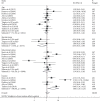Prevalence of Urinary Tract Infection and Its Associated Factors among Pregnant Women in Ethiopia: A Systematic Review and Meta-Analysis
- PMID: 34901276
- PMCID: PMC8654570
- DOI: 10.1155/2021/6551526
Prevalence of Urinary Tract Infection and Its Associated Factors among Pregnant Women in Ethiopia: A Systematic Review and Meta-Analysis
Abstract
Objective: Urinary tract infection (UTI) is the most common bacterial infections during pregnancy. It is associated with different maternal and neonatal adverse outcomes such as low birth weight, preterm birth, still birth, preeclampsia, maternal anemia, sepsis, and amnionitis, even when the infection is asymptomatic. However, in Ethiopia, it is represented with fragmented and inconclusive pocket studies. Therefore, this systematic review and meta-analysis is aimed at estimating the pooled prevalence of UTI and its associated factors among pregnant women in Ethiopia.
Methods: PubMed/Medline, Embase, Cochrane Library, Google Scholar, and local sources were used to access eligible studies. Joanna Briggs Institute Meta-Analysis of Statistics Assessment and Review Instrument was applied for critical appraisal. Heterogeneity and publication bias were evaluated using I 2 statistic, funnel plot asymmetry, and Egger's tests. Random effect model was employed to estimate the pooled burden of UTI and its associated factors among pregnant women with its corresponding odds ratio (OR) and 95% confidence interval (CI).
Result: From all systematically searched articles, 14 studies were eligible for this analysis. The overall pooled prevalence of UTI among pregnant women in Ethiopia was 15.37% (95% CI: 12.54, 18.19). Family monthly income (OR = 3.8 and 95% CI: 1.29, 11.23), parity (OR = 1.59 and 95% CI: 1.01, 2.50), history of catheterization (OR = 2.76 and 95% CI: 1.31, 5.84), and history of UTI (OR = 3.12 and 95% CI: 1.74, 5.60) were factors significantly associated with UTI among pregnant women in Ethiopia.
Conclusion: The overall pooled estimate of UTI among pregnant women in Ethiopia was higher compared with CDC estimation which was 8%. Family monthly income < 1000ETB, multipara, previous history of catheterization, and history of UTI were factors increased burden of UTI during pregnancy. So, strategies targeting in economic reforms, universal access of family planning, and standardized prenatal care service should be addressed to alleviate this high prevalence of UTI during pregnancy.
Copyright © 2021 Temesgen Getaneh et al.
Conflict of interest statement
The authors have declared that there are no competing interests.
Figures






Similar articles
-
The impact of pregnancy induced hypertension on low birth weight in Ethiopia: systematic review and meta-analysis.Ital J Pediatr. 2020 Nov 26;46(1):174. doi: 10.1186/s13052-020-00926-0. Ital J Pediatr. 2020. PMID: 33243285 Free PMC article.
-
Prevalence of homebirth preference and associated factors among pregnant women in Ethiopia: Systematic review and meta-analysis.PLoS One. 2023 Nov 15;18(11):e0291394. doi: 10.1371/journal.pone.0291394. eCollection 2023. PLoS One. 2023. PMID: 37967092 Free PMC article.
-
Prevalence of surgical site infection and its associated factors after cesarean section in Ethiopia: systematic review and meta-analysis.BMC Pregnancy Childbirth. 2020 May 20;20(1):311. doi: 10.1186/s12884-020-03005-8. BMC Pregnancy Childbirth. 2020. PMID: 32434486 Free PMC article.
-
Magnitude and associated factors of urinary tract infections among adults living with HIV in Ethiopia. Systematic review and meta-analysis.PLoS One. 2022 Apr 1;17(4):e0264732. doi: 10.1371/journal.pone.0264732. eCollection 2022. PLoS One. 2022. PMID: 35363782 Free PMC article.
-
Associated risk factors of urinary tract infection among pregnant women at Felege Hiwot Referral Hospital, Bahir Dar, North West Ethiopia.BMC Res Notes. 2013 Jul 25;6:292. doi: 10.1186/1756-0500-6-292. BMC Res Notes. 2013. PMID: 23885968 Free PMC article.
Cited by
-
Bacterial profile and prevalence of urinary tract infections in pregnant women in Latin America: a systematic review and meta-analysis.BMC Pregnancy Childbirth. 2023 Nov 8;23(1):774. doi: 10.1186/s12884-023-06060-z. BMC Pregnancy Childbirth. 2023. PMID: 37940852 Free PMC article.
-
Urinary tract infections among pregnant women in rural West Amhara, Ethiopia: Prevalence, bacterial etiology, risk factors, and antimicrobial resistance patterns.Res Sq [Preprint]. 2025 Jan 9:rs.3.rs-5737078. doi: 10.21203/rs.3.rs-5737078/v1. Res Sq. 2025. PMID: 39866875 Free PMC article. Preprint.
-
[Prevalence and risk factors of urinary tract infection in pregnant women].Rev Med Inst Mex Seguro Soc. 2023 Sep 4;61(5):590-596. doi: 10.5281/zenodo.8316437. Rev Med Inst Mex Seguro Soc. 2023. PMID: 37768892 Free PMC article. Spanish.
-
Determinants of preterm prelabor rupture of fetal membrane among pregnant women in Ethiopia: A systematic review and meta-analysis.PLoS One. 2024 Nov 8;19(11):e0311151. doi: 10.1371/journal.pone.0311151. eCollection 2024. PLoS One. 2024. PMID: 39514514 Free PMC article.
-
Prevalence of urinary tract infections in pregnancy in rural Andean communities of Peru.Womens Health (Lond). 2024 Jan-Dec;20:17455057241294215. doi: 10.1177/17455057241294215. Womens Health (Lond). 2024. PMID: 39498785 Free PMC article.
References
-
- Haider G., Zehra N., Munir A. A., Haider A. Risk factors of urinary tract infection in pregnancy. JPMA The Journal of the Pakistan Medical Association . 2010;60(3):213–216. - PubMed
-
- Delzell J. E., Jr., LeFevre M. Urinary tract infections during pregnancy. American Family Physician . 2000;61(3):713–721. - PubMed
Publication types
MeSH terms
LinkOut - more resources
Full Text Sources
Medical

